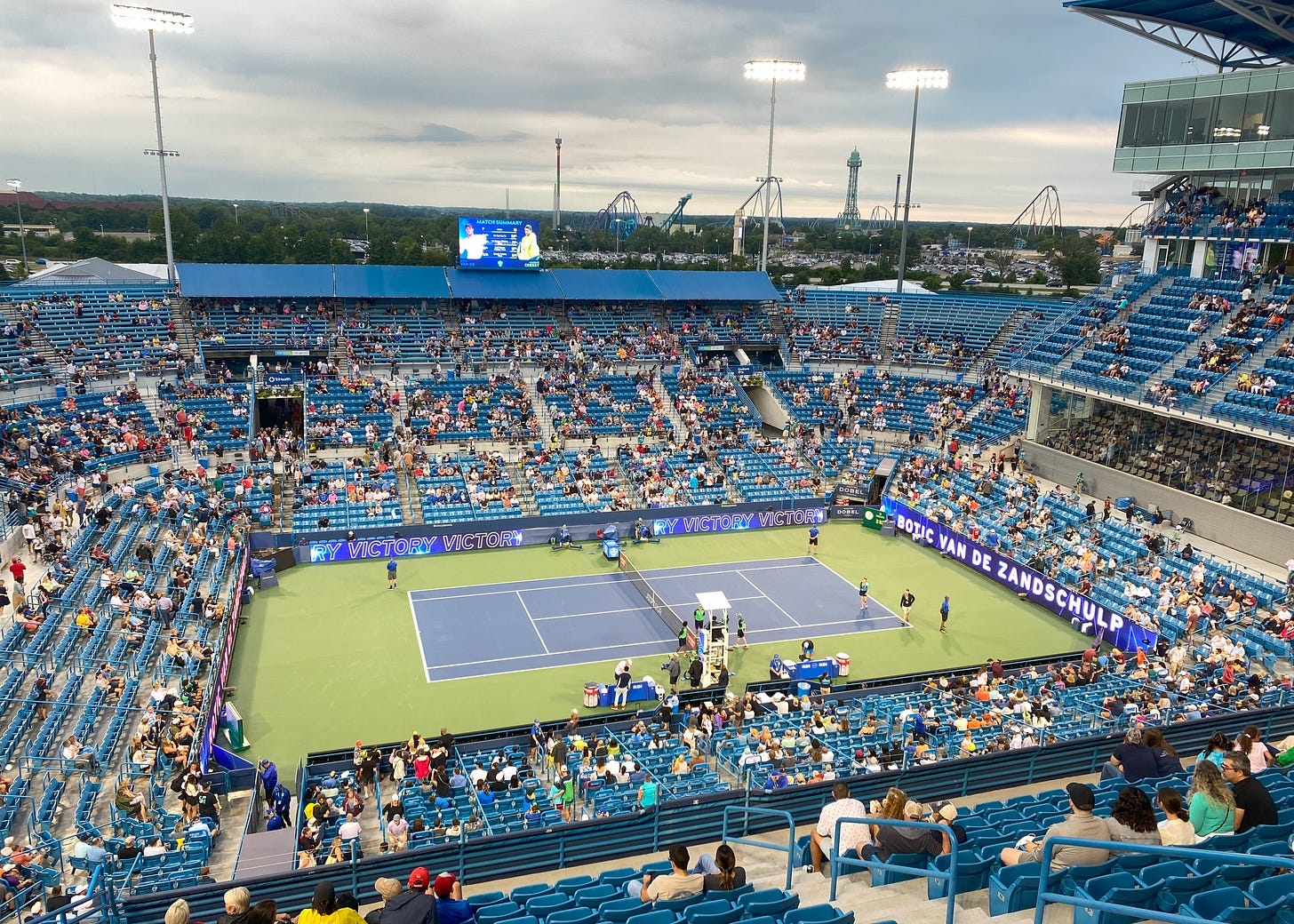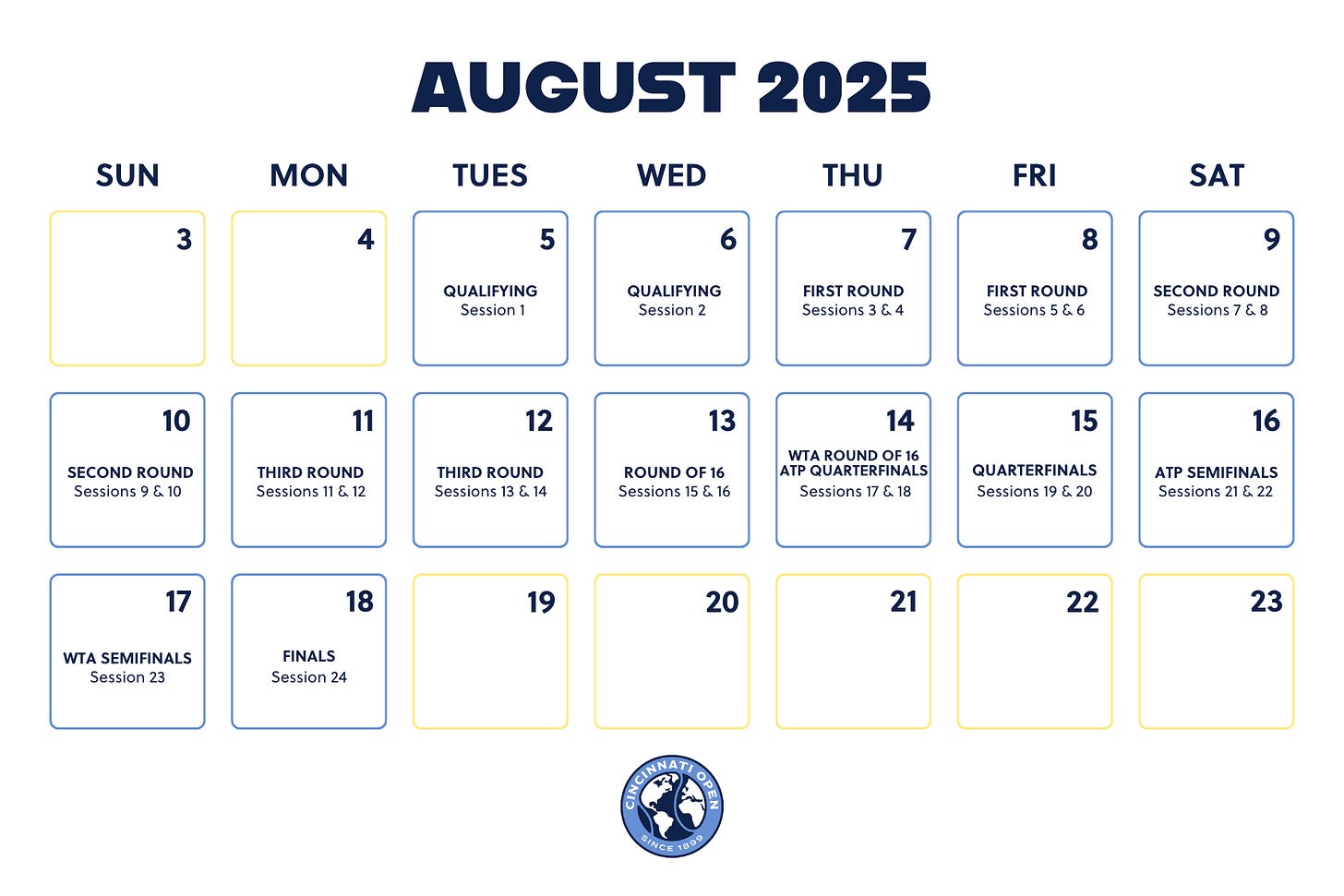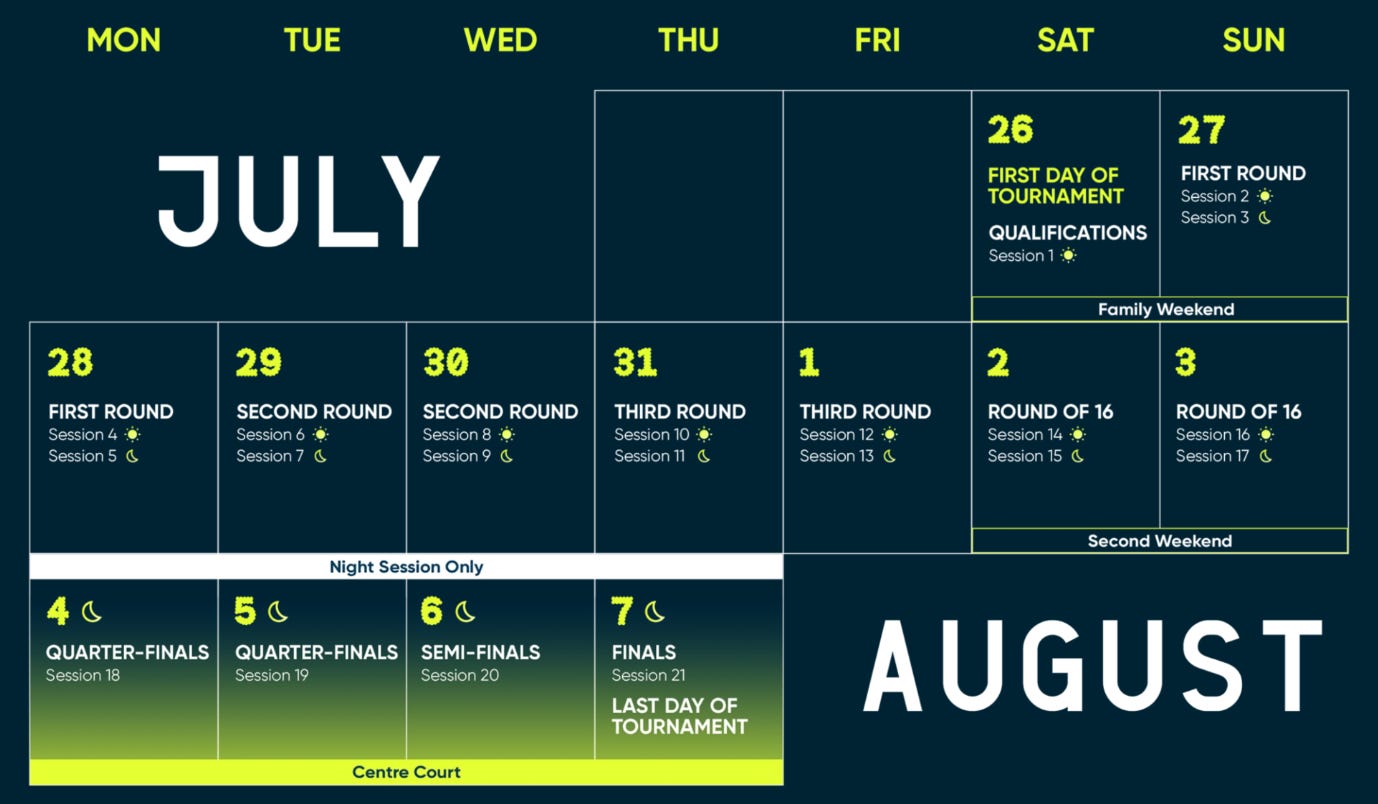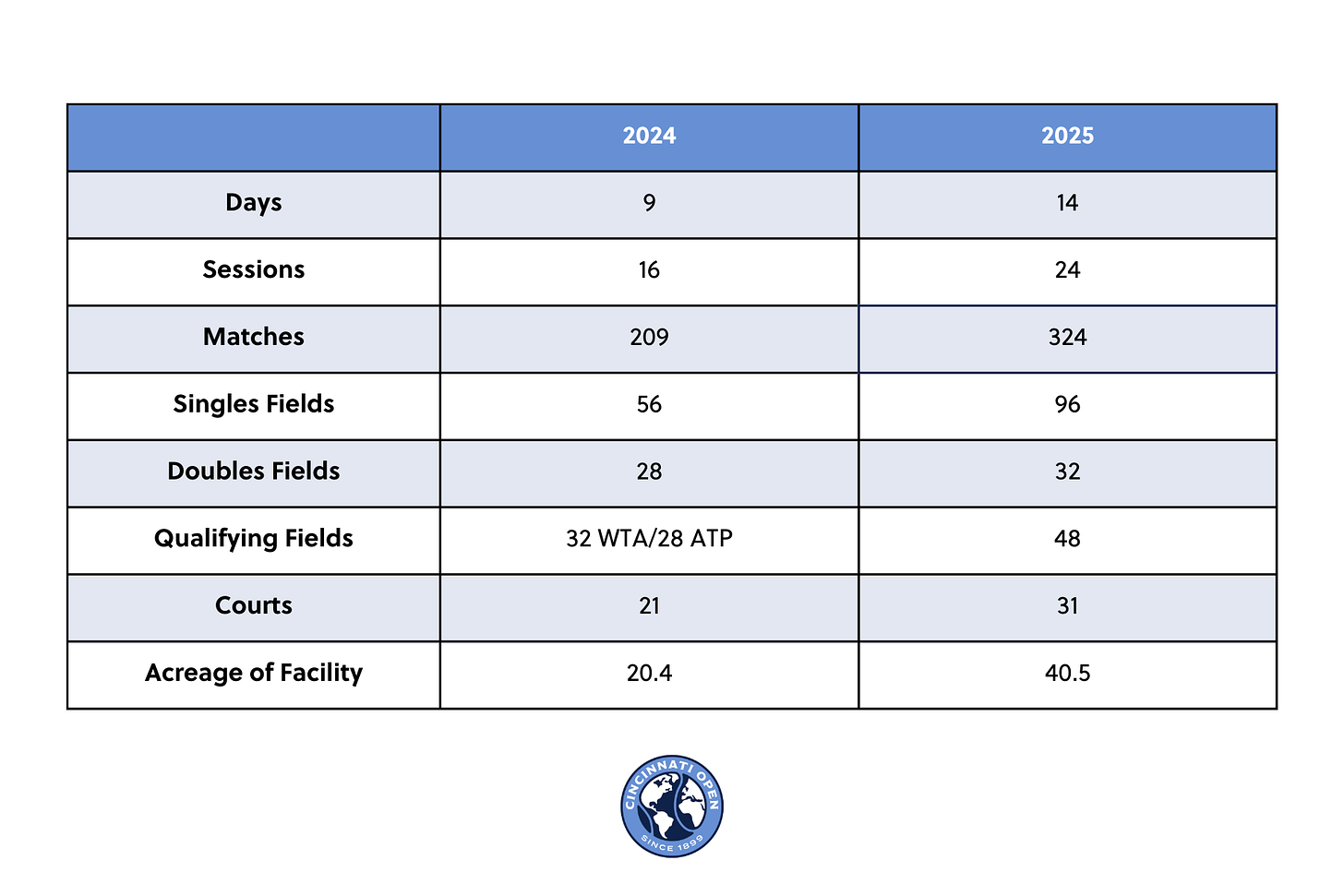
The Dog Weekdays of Summer
Popular tournaments in Canada and Cincinnati are wearing out their welcome with bloated schedules.
I wouldn’t have imagined that I’d be writing a second piece so soon about what day of the week things are going to be happening this August, but the strong reactions I got Wednesday to sharing the newly announced calendar for the 2025 Cincinnati Open made me think it was worth another Bounces dispatch on the topic.
The Cincinnati Open, a combined ATP-WTA 1000 event that has long stood as both the biggest tournament in the American Midwest and the biggest warm-up event for the U.S. Open, announced in a press release Wednesday that its 2025 tournament schedule will be stretched across 14 days instead of 9 days, with qualifying beginning on a Tuesday, main draw play beginning on a Thursday, and the finals being played on a Monday.
I shared this new schedule alongside the new schedule for the preceding tournaments in Canada—WTA 1000 Montreal and ATP 1000 Toronto—which will conclude with an even more unusual Thursday final.
Reactions on both my Twitter and Bluesky posts were unanimously negative.
We had known that these tournaments were going to be moving from taking up two back-to-back weeks in the calendar to three, but the way that they have draped themselves across these three weeks of the calendar feels haphazard and lumpy.
It’s part of a larger trend, of course: 1000-level events in Madrid and Rome also expanded to being two-week, 96-player draws in 2023, and that has also meaningfully diminished the value fans get at those tournaments…but at least they stayed within the normal framework of having their finals on the weekend.
Changes For Worse:
When I wrote last week about the U.S. Open moving up its start date by one day to begin on a Sunday this year, I broke down the winners and losers from this shift, across various categories of tennis stakeholders, from players to fans and beyond, since I think the impact of that move is mixed.
I think it’s much simpler to assess the damage from these newfangled schedules for Canada and Cincinnati: Almost everybody clearly loses!
Though the way both are worsening have a lot in common, let’s briefly look at each of these two tournaments separately.
Cincinnati

Cincinnati has been one of my favorite tournaments to attend and cover for a long time, and it’s one I’ve routinely recommended to tennis fans who want to travel for a tennis-focused trip.
If you don’t mind there being very little besides watch tennis to do once you get there, Mason, Ohio has been a great place to go each August. It’s a lot more affordable than most other tennis destinations, all the top players are reliably playing there and motivated, and the schedule is jam-packed with matches that can be seen on grounds pass-accessible courts (and the main stadium hasn’t been overly pricy either). Even the qualifying matches held on the opening weekend of Cincinnati were usually worth the trip on their own, frequently featuring matches between Top ~70 players (and with the ability to watch the biggest stars practicing on-site, too).
All of those attractive selling points get worse with the newly bloated schedule, which adds enormous quantity that dilutes the high quality considerably. With a lower cut-off and larger draw, the qualifying draw will now feature far weaker players, and because of the byes now in place the first round of the main draw won’t feature anyone in the top 32. While the first round in Cincinnati’s old 56-player draws (with 16 seeds) used to routinely pit Top 30 or even Top 20 players against one another from the opening day of main draw play, now you won’t get any matches between two Top 30 players until the third round at the earliest.
The Cincinnati Open’s Wednesday press release provided this handy table to show the many categories of expansion for this year’s event:
The table was surely meant to mean that bigger is better, but I just don’t see it that way at all. The increase from 209 to 324 matches, to my uncharitable eye, has to be understood to mean that the new 115 additional matches are all going to be worse expected value than the preexisting matches.
Then you take that worse quality and spread it out over a longer time window. To see the same amount of top-level tennis, you’ll have to double the length of your stay, at least, and perhaps double the number of tickets to separate sessions you previously would have needed to buy.
And then there’s the truly bizarre ending to the Cincinnati schedule with a Monday final. For why? The men’s and women’s semifinals could easily be held together on one day, on the Saturday, allowing for the final to be on Sunday. But instead, the tournament decided to split the two men’s semifinals into two separate one-match sessions on the Saturday, pushing the women’s semifinals into Sunday by themselves, and then the finals into Monday.1
Distending the ending like this, when there would have been plenty of space to finish on the weekend, feels to me like a considerable middle finger to ticket buyers, and even to people who want to watch from home in various time zones. Why put the climax of the tournament on a weekday when it didn’t need to be? Especially since there’s a considerable number of out-of-town attendees at the tournament, it’s just a massive disservice to ticketholders to make them book an extra night for their trip and miss a day of work.
As one tweeter put it: “Sigh. The dilution of the sessions is sad, and I still do not get why they are scheduling the final on Monday night - people can drive in from all over the Midwest for weekends, but a Monday night audience is much more limited.”
(I’ve been focused mostly on fans, but to state the obvious: players obviously won’t want to spend twice as long in Mason, Ohio for roughly the same amount of money.)
Monday men’s singles finals were common for a stretch at the U.S. Open, happening every year from 2008 to 2014. There were two factors at play there as the tournament almost always decided to host a Monday final midway through the tournament: the schedule struggled with heavy rain in the years before the roof was added to Arthur Ashe Stadium, and the tournament was also grappling with its outdated practice of scheduling the men’s semifinals and finals on back-to-back days on the final weekend, which was increasingly impractical as best-of-five matches grew longer and more physical.
But those Monday finals in New York were almost always, rightly, seen as a failure of the schedule, never a clever fix. And at least in those Grand Slam finals, the contenders had nowhere else they’d rather to be; keeping players in Cincinnati longer is just going to make them antsier to get to New York.
Canada
Almost everything I said about adding quantity and diluting quality also applies to the two simultaneous events in Canada, too. The Canadian arrangement isn’t quite as bad, though, since it’s only expanded to 13 days instead of 14, but the tournament is also spread across two cities, meaning that there was already less quantity to begin with.
Just on a buzz level, having the four biggest nights of the competition run Monday-through-Thursday in Canada is just strange. Having the quarterfinals, semifinals, and finals all as weeknight sessions at least is better for working fans, but if everything is a night session there’s also going to be considerable overlap between the most important matches at each of the two tournaments, which used to be more staggered to allow fans watching on television in Canada and beyond to enjoy both tournaments.
Impacts Elsewhere
Not only are these expanding 1000-level events worsening themselves, they also have clear detrimental effects elsewhere, worsening the product for fans in other markets, too.
Newport and Atlanta, two ATP 250 events, both fell off the ATP calendar this year,2 clear casualties of the 1000s spreading. The combined ATP-WTA 500 tournament in Washington was also shoved a week earlier by the Canada-Cincinnati double expanding from two weeks to three. Since it now begins just one week after the Wimbledon finals—and before two daunting slogs in Canada and Cincinnati—it’s hard to imagine that the Washington field will be as strong as it has been in recent years.
Is This Good for Anyone?
When I said above that “everybody loses,” I meant it. I think this is such a dilution and devaluation of the product that anything gained in revenue will be offset in resentment from players and fans alike.
The only group that could genuinely benefit, I think, is players who are ranked in the 100-150 range that never previously would have gotten them near entering tournaments of this caliber but can now play the qualifying draw in Cincinnati or Canada. These earning opportunities could help them out, especially if they can somehow win a few matches.
But still, I don’t think that justifies such a disruptive change to the events. I’m supportive of players ranked ~100th making more money, but I think those earnings should be boosted directly for feats like winning Challenger titles, not for showing up to pad draws at big tournaments.
Is there any hope of the tour coming to its senses about these and other bloated 1000-level events? Not immediately, alas. The ATP Calendar is already out for 2026, and it looks roughly the same (albeit with an extra week between Wimbledon and Washington).
There’s another Olympic year coming in 2028, though, and perhaps the tournaments could recondense to accommodate that and then realize how good they had it before?
Or perhaps the two-week mega-1000 model can be rethought and scrapped writ large if there’s enough continuous complaint from players, fans, and other parties.
It shouldn’t always be about greed winning out in tennis, one hopes against hope.
Thanks for reading Bounces! I’m curious for reader feedback on this topic particularly, to hear from folks who watch and attend these tournaments, so please do sound off in the comments. And please continue sending in mailbag questions! -Ben
The Cincinnati finals were also on a Monday last year, but honestly I assumed it was an Olympic year oddity and not any sort of more permanent plan. I was wrong!
Newport downgraded to an ATP Challenger event, which will be held simultaneously with a new WTA 125 event.










The Cincinnati Open is my favorite tournament. I've had series passes for the past 10 years and have to travel to get there. I've been dreading this change. I debated buying a series pass this year, but I did it anyway even though there is no way that I will be there for the entire event.
In the old format, I actually loved the qualifying and early rounds - so many high quality matches going on at the same time! You could easily switch matches if one was boring or something exciting was going on elsewhere. Now, I'm planning to skip qualifying and probably round 1. I may not even stay for the semis and finals. The final 2 days were always iffy anyway. What happens if they feature players I either don't like or don't care about? There are no other alternatives. Now, with them spread out more, it's even worse. I may end up selling them, thus recouping some of the inflated cost of this expanded tournament.
The expansion of the Masters has gone too far…..
Especially when they’re doing it for WTA only/ATP only events - you just don’t need to drag them out for that long. Plus Shanghai expanding has led to similar weird midweek finals and start dates in Tokyo/Beijing & the 250’s before them - when it’s totally unnecessary.
As for $$ opportunities for lower ranked players - a few players have said when they’ve qualified/won a few rounds that their expenses have gone up a lot (if they have a coach/team with them - then they’re paying for an extra hotel room - and the tournament hotels are usually pricey)
In Rome/Madrid when they take up a whole month, it also means a lot of players only get 2 matches in during that time. The CH175’s are good, but due to the scheduling a lot of players that want to play those are unable to (and they’re mainly benefitting players ranked 25ish-80)
Watching on TV they just lose all momentum as they drag on for so long, it’s difficult to stay interested.
It seems like they’re just trying to compete with the slams - but it’s a much less compelling version of that. The old format where you’d get the best players facing early was what made them unique and “premium”, not how long they go for.
The best ATP events now (aside from MC & Paris that haven’t expanded) are the weeks with 2 x 500’s. They have strong fields, they’re condensed - and on Tennis TV there’s more matches with commentary than you get at the 1000’s
Hopefully they come to their senses about this - hogging up and dragging out the calendar with diluted events surely isn’t the answer